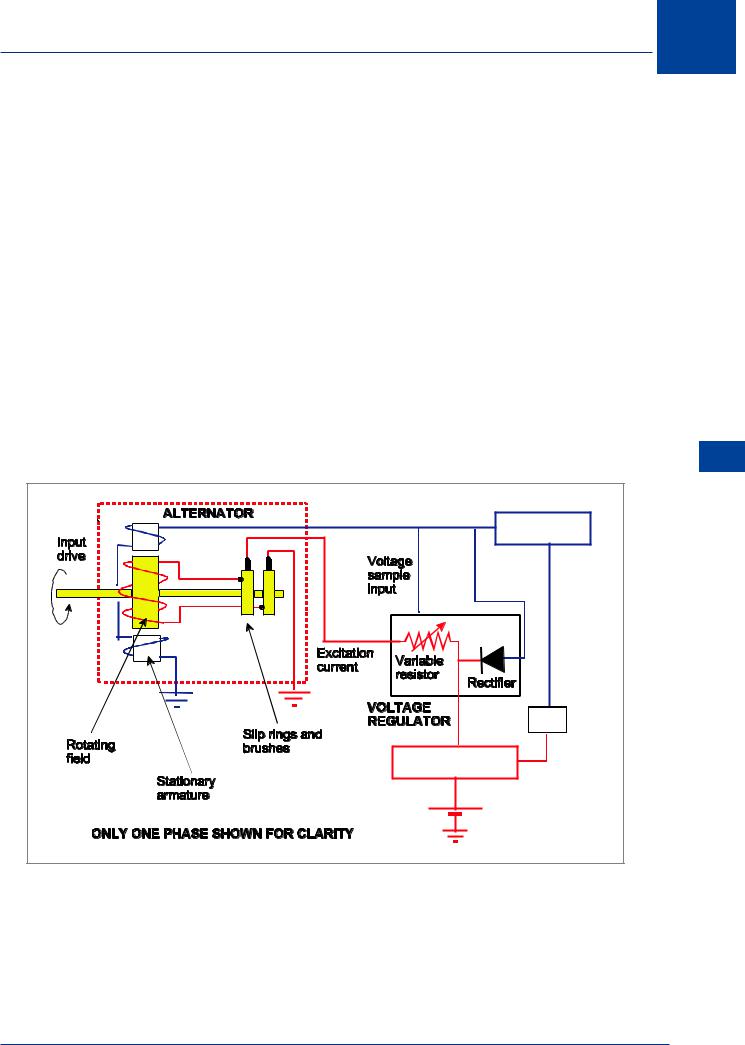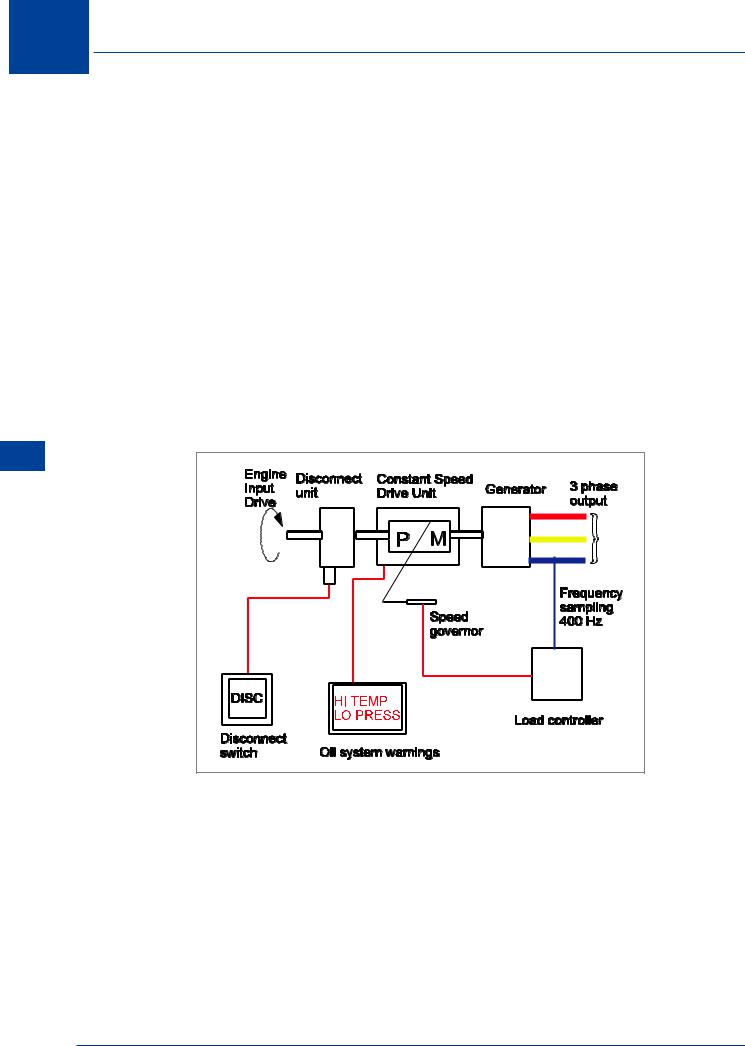
- •Textbook Series
- •Contents
- •1 DC Electrics - Basic Principles
- •Introduction
- •Electromotive Force (EMF)
- •Current
- •Resistance
- •Factors Affecting the Resistance
- •Units of Resistance
- •Resistors
- •Power
- •Series and Parallel Circuits
- •Kirchoff’s Laws
- •Annex A
- •2 DC Electrics - Switches
- •Switches
- •Proximity Detectors
- •Time Switches
- •Centrifugal Switches
- •3 DC Electrics - Circuit Protection and Capacitors
- •Electrical Faults
- •Circuit Protection Devices
- •Fuses
- •The Cartridge Fuse
- •Spare Fuses
- •High Rupture Capacity (HRC) Fuses
- •Dummy Fuses
- •Current Limiters
- •Circuit Breakers
- •Reverse Current Circuit Breakers
- •Capacitors
- •Capacitance
- •Capacitor in a DC Circuit
- •Capacitor in an AC Circuit
- •Capacitors in Parallel
- •Capacitors in Series
- •4 DC Electrics - Batteries
- •Batteries
- •Secondary Cells
- •Lead Acid Battery
- •Alkaline Battery (Nickel Cadmium, NiCad)
- •Battery Checks
- •Battery Charging
- •Secondary Batteries Summary
- •5 DC Electrics - Magnetism
- •Magnetism
- •Temporary Magnets
- •Permanent Magnets
- •Permeability
- •Magnetism
- •The Molecular Structure of Magnets
- •The Magnetic Effect of a Current
- •The Corkscrew Rule
- •The Magnetic Field of a Solenoid
- •The Right Hand Grasp Rule
- •The Strength of the Field of a Solenoid
- •Solenoid and Relay
- •The Forces on a Conductor Which is Carrying a Current
- •Questions
- •Answers
- •6 DC Electrics - Generators and Alternators
- •Electromagnetic Induction
- •Fleming’s Right Hand Rule
- •Faraday’s Law
- •Lenz’s Law
- •Simple Generator
- •Simple DC Generator
- •Characteristics of the Series Wound DC Generator
- •Commutator Ripple
- •Characteristics of the Shunt Wound DC Generator
- •A Compound Wound DC Generator
- •Flashing the Generator Field
- •Alternators
- •Voltage Control
- •Voltage Regulator Operation
- •Layout of a Generator System
- •Load Sharing Circuits
- •Operation of Load Sharing Circuit
- •7 DC Electrics - DC Motors
- •Electric Motors
- •Fleming’s Left Hand Rule
- •Practical DC Motor
- •Back EMF
- •Slow Start Resistor
- •Commutation
- •Series Wound Motors
- •Shunt Wound Motors
- •Starter-generator Systems
- •Actuators
- •Solenoid Actuators
- •Motor Actuator Construction
- •The Split Field Series Actuator
- •The Split Field Series Actuator Operation
- •Motor Actuators
- •Rotary Actuators
- •Linear Actuators
- •Actuator Brakes
- •Actuator Clutches
- •Visual Indicators Used with Linear Actuators
- •Visual Indicators Used with Rotary Actuators
- •Indicator Lights
- •Electromagnetic Indicators
- •Questions
- •Answers
- •8 DC Electrics - Aircraft Electrical Power Systems
- •Aircraft Electrical Power Systems
- •Dipole or Two Wire System
- •Single Pole (Unipole or Earth Return) System
- •Generators and Alternators
- •Voltage Regulators
- •Overvoltage Protection Unit
- •Generator Cut-out or Reverse Current Relay
- •Rectifiers
- •Inverters
- •The Generator Differential Cut-out
- •Generator (or Alternator) Warning Light
- •Generator (or Alternator) Master Switch
- •Monitoring Instruments
- •Ammeters and Voltmeters
- •The Battery
- •Bus Bars
- •Bus Bar Systems
- •Parallel Bus Bar System
- •Load Shedding
- •Generator or Alternator Failure
- •9 DC Electrics - Bonding and Screening
- •Bonding
- •The Static Discharge System or Static Wicks
- •Discharge of Static on Touchdown
- •Screening
- •Questions
- •Answers
- •10 DC Electrics - Specimen Questions
- •Questions – General 1
- •Questions – General 2
- •Answers – General 1
- •Answers – General 2
- •11 AC Electrics - Introduction to AC
- •Introduction
- •The Nature of Alternating Current
- •Terms
- •The Relationship of Current and Voltage in an AC Circuit
- •Resistance in AC Circuits
- •Inductance in AC Circuits
- •Inductive Reactance
- •Capacitance in AC Circuits
- •Capacitive Reactance
- •Impedance
- •Resonant Circuits
- •Summary
- •Power in AC Circuits
- •Power in a Purely Resistive Circuit
- •Power in a Purely Inductive Circuit
- •Power in a Capacitive Circuit
- •Power in a Practical AC Circuit
- •Power Factor
- •Power Factor Resume
- •Questions
- •Answers
- •12 AC Electrics - Alternators
- •Introduction to Aircraft Power Supplies
- •Generators / Alternators
- •Rotating Armature Alternator
- •Rotating Field Alternator
- •Alternator Output Rating
- •A Single Phase Alternator
- •Polyphase Circuits
- •Three Phase Alternator Connections
- •The Four Wire Star Connection
- •Delta Connected Alternator
- •Practical AC Generators
- •Brushed Alternators
- •Brushless Alternators
- •Frequency Wild Alternators
- •Obtaining a Constant Frequency Supply from a Frequency Wild System
- •Constant Frequency Alternators
- •Constant Speed Generator Drive Systems
- •CSDU Fault Indications in the Cockpit
- •The Drive Disconnect Unit (Dog Clutch Disconnect)
- •Variable Speed Constant Frequency Power Systems (VSCF)
- •Self-excited Generators
- •Load Sharing or Paralleling of Constant Frequency Alternators
- •Real Load
- •Reactive Load
- •Parallel Connection
- •Before Connecting in Parallel
- •Layout of a Paralleled System
- •Real Load Sharing
- •Reactive Load Sharing
- •Load Sharing General
- •Alternator Cooling
- •Generator Fault Protection
- •Bus Tie Breakers (BTBs)
- •Discriminatory Circuits
- •Differential Fault Protection
- •Synchronizing Units
- •Generator Failure Warning Light
- •Load Meters
- •Voltage and Frequency Meters
- •Generator Control Unit (GCU)
- •Emergency Supplies
- •The Ram Air Turbine (RAT)
- •The Auxiliary Power Unit (APU)
- •The Static Inverter
- •Ground Power Constant Frequency Supply System
- •Typical Controls and Indications
- •Questions
- •Answers
- •13 AC Electrics - Practical Aircraft Systems
- •Power Distribution
- •The Split Bus System
- •Parallel Bus Bar System
- •Questions
- •Answers
- •14 AC Electrics - Transformers
- •Transformers
- •Transformation Ratio
- •Power in a Transformer
- •Three Phase Transformers
- •Autotransformers
- •Rectification of Alternating Current
- •Half Wave Rectification
- •Full Wave Rectification
- •Three Phase Rectifiers
- •Transformer Rectifier Units (TRUs)
- •Inverters
- •Questions
- •Answers
- •15 AC Electrics - AC Motors
- •Alternating Current Motors
- •The Principle of Operation of AC Motors
- •The Synchronous Motor
- •The Induction Motor
- •The Squirrel Cage Rotor
- •The Induction Motor Stator
- •Slip Speed
- •Starting Single Phase Induction Motors
- •Fault Operation
- •Questions
- •Answers
- •16 AC Electrics - Semiconductors
- •An Introduction to Semiconductors
- •Conductors and Insulators
- •Semiconductors
- •N-Type Material
- •P-Type Material
- •Current Flow
- •The P-N Junction
- •Reverse Bias
- •Forward Bias
- •The Junction Diode
- •The Bipolar or Junction Transistor
- •Summary
- •17 AC Electrics - Logic Gates
- •An Introduction to Logic Gates
- •Binary Logic
- •Truth Tables
- •Gate Symbols
- •Positive and Negative Logic
- •The ‘AND’ Gate
- •The ‘OR’ Gate
- •The ‘INVERT’ or ‘NOT’ Gate
- •The ‘NAND’ Gate
- •The ‘NOR’ Gate
- •The ‘EXCLUSIVE OR’ Gate
- •Questions
- •Answers
- •18 Index

AC Electrics - Alternators
Rotating Field alternators make up the majority in use. From the previous sections it will be seen that in this type of alternator the field is in the rotor and the phase windings form the stator.
There are two types of rotating field alternator in use on aircraft:
•Brushed alternators.
•Brushless alternators.
Brushed Alternators
The current supply for the excitation of the rotor field can be provided initially from the aircraft DC bus bar (battery) and then subsequently by rectified AC. The DC current is directed through brushes and slip rings to the rotating field.
Control of the excitation current is by the voltage regulator which samples the alternator output (115 V AC) and adjusts the excitation current to maintain the correct voltage irrespective of the alternator speed and loads.
The voltage regulator in its simplest form is a variable resistance connected in series with the field coil (the principle of the carbon pile regulator in Chapter 6, page 93 ).
115 V AC BUS |
TRU |
28 V DC BUS BAR |
Figure 12.7 Brushed alternator
12
AC Electrics - Alternators 12
193

12 AC Electrics -Alternators
Alternators - Electrics AC 12
Brushless Alternators
115 V AC BUS |
TRU |
28 V DC BUS BAR |
Figure 12.8 Brushless alternator
A brushless alternator incorporates an exciter generator mounted on the same shaft as the main generator. The purpose of the exciter generator is to provide a current for the main generator rotating field. The rotating rectifier converts the AC produced in the exciter armature to DC required for the main rotor field supply.
Voltage regulation is effected by controlling the exciter field strength and thereby the current strength at the main rotor field coil.
Brushless alternators have some advantages over brushed alternators:
•They are very reliable
•There are no brush wear problems
•They have a high power to weight ratio
Modern brushless alternators may have a third generator on the same shaft called a Permanent Magnet Generator (PMG) which provides excitation current for its exciter generator. Alternator output is usually 115 V/200 V/400 Hz/3 phase.
There are two basic types of brushless alternator:
•Externally excited. (No residual magnetism in the exciter)
•Self-excited. (Some residual magnetism in the exciter)
Frequency Wild Alternators
If an alternator is driven directly from the engine gearbox then its speed, and therefore the frequency of its output, will vary directly with engine speed. An output from such a generator is said to be Frequency Wild.
NOTE: The connection of two frequency wild generators in parallel is not possible.
194

AC Electrics - Alternators 12
Frequency wild alternators are usually used on aircraft to power the electrical de-icing systems, where the resistances that make up the heater mats are not affected by changing frequencies.
Obtaining a Constant Frequency Supply from a Frequency Wild System
Inverters can be used to give a constant frequency output from a frequency wild supply. The frequency wild AC is rectified to DC which is used to power a Static Inverter which then converts DC to constant frequency AC.
Constant Frequency Alternators
If an alternator can be driven at a constant speed, then the output frequency will be constant. Driving the engine at a constant speed is not a practical proposition so a device is required to keep the speed of the alternator constant irrespective of the engine speed.
Constant Speed Generator Drive Systems
The Constant Speed Drive Unit (CSDU) consists of an engine driven hydraulic pump, the output of which drives a hydraulic motor which itself in turn drives the alternator.
The oil which forms the fluid, through which the mechanism operates and also facilitates lubrication and cooling, is contained within a reservoir, entirely separate from the engine oil system. The output of the hydraulic pump, and therefore the speed of the hydraulic motor, depends on the angle of a swash plate within the pump. The angle of the swash plate is controlled by a device called a speed governor. The speed governor is controlled by the load controller which senses the output frequency of the alternator and is responsible for increasing or decreasing the torque output of the CSDU to the alternator drive.
Most CSDUs are capable of maintaining the alternator output frequency within 5% of 400 Hz (380 - 420 Hz).
In the event of a mechanical failure in the alternator, the CSDU is protected by a Quill Drive; this is the equivalent of a weak link which will break before any major damage can be caused.
The CSDU operates in one of three modes: overdrive, straight through drive or underdrive.
• |
Overdrive |
= engine speed less than generator speed |
• |
Straight through drive = engine speed same as generator speed |
|
• |
Underdrive |
= engine speed greater than generator speed |
Some constant frequency generators have their CSDU and generator combined in one unit called an Integrated Drive Unit (IDU) or Integrated Drive Generator (IDG).
CSDU Fault Indications in the Cockpit
There are several indications in the cockpit associated with the Constant Speed Drive Unit and the problems which might occur with it. The two main ones are:
•Low Oil Pressure Warning Lights. These will illuminate when the oil pressure drops below a predetermined minimum value.
•High Oil Temperature warning. This allows the CSDU oil outlet temperature to be monitored.
AC Electrics - Alternators 12
195

12 AC Electrics -Alternators
The Drive Disconnect Unit (Dog Clutch Disconnect)
In the unlikely event of a malfunction in the CSDU or the alternator, the engine input drive to the CSDU can be disconnected. This will allow both the drive unit and the alternator to become stationary, thus eliminating any chance that the malfunction will affect engine performance.
The disconnection can be carried out at any time the engine is running, although reconnecting may only be done “manually” on the ground following shut down of the engine.
Figure 12.9 illustrates a CSDU and the drive disconnect mechanism. The disconnect unit is operated by the selection of a momentary action ‘Drive Disconnect’ switch by the pilot. This operates a solenoid which causes a mechanical separation of the input drive from the engine to the constant speed unit. Exceptionally, some aircraft may allow automatic disconnection of the generator drive by a generator control unit (GCU) under certain fault conditions.
Some IDGs are known as Permanent Magnet Generators (PMGs). The generator has three separate generators on the same shaft: a permanent magnet generator which provides for initial excitation of the exciter generator which controls the main generator field. This type of generator is invariably controlled by a Generator Control Unit (GCU).
Alternators - Electrics AC 12
Figure 12.9
Variable Speed Constant Frequency Power Systems (VSCF)
A variable speed constant frequency system (VSCF) uses a frequency wild generator driven by the engine and the variable frequency output is electronically converted into a constant frequency 400 Hz supply. The conversion is achieved by a generator converter control unit (GCCU) which first passes the variable frequency supply through a full wave rectifier where it is rectified and filtered and then to an inverter where it is formed into a 115 V/ 200 V/ 400 Hz/ 3 phase supply. This of course eliminates the need for a hydromechanical CSDU and all its associated controlling mechanisms. This improves reliability and flexibility on the installation as the electronic circuit does not necessarily have to be located in the engine compartment with the generator. VSCF systems are currently fitted to Boeing 737 aircraft and several military
196
